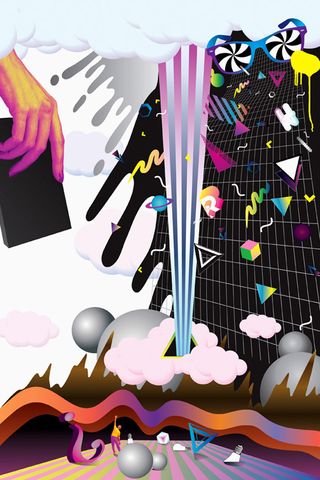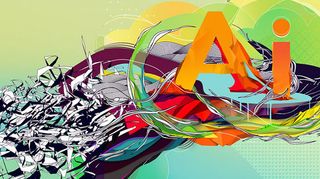20 pro tips to take vector illustration to the next level
Rob Carney speaks to the world's top illustrators to give you essential tips for progressing your vector illustration career.
Over the course of interviewing some of the world's best established and up-and-coming illustrators for this set of professional tips, one thing has become clear. No matter how you work - whatever medium or software you choose - the concept, or idea, is the most important part of your piece.
Every single one of the talented illustrators and designers that we've featured here confirmed this, before going on to offer their valuable software and industry-focused nuggets of advice to help you further your skills and career.
You may know most of these tips, but if there's even one nugget that you weren't aware of then you'll improve your work. So, before you embark on that new killer concept, take heed of the great advice on offer to make the most of Illustrator and take your creations to the next level.
01. Supply it right
"Always ask the client how they want the final image. If they want the Illustrator file, and you have lots of layers but don't want to move them to a new artwork one by one, it's easier to draw a large rectangle over the final image, Ctrl+right-click, and select 'Create a Clipping Mask'. This crops your artwork to the shape you drew."
Aaron Miller
Freelance illustrator, www.aaronmillerillustration.com
02. Learn the Bezier tools
"Working with a Wacom tablet, I'm a big supporter of the Pen tool. The Bezier curves take time to learn, but are a super-efficient way to get the exact lines and shapes you want. Use the Alt/Option key to drag off a copy, instead of copy and paste, and learn all the tool shortcuts to save precious minutes."
Ben the Illustrator
Illustrator and designer, www.bentheillustrator.com
03. Start out right
"Consider the technology that will produce the work - you approach a full-colour image for a print magazine differently than something you'd spray on a wall. Our wall decal illustrations have to be simple, one-dimensional and easy to cut out, so we use styles from the '60s and '70s with elementary shapes."
Kitsch Nitsch
Illustrators, www.kitsch-nitsch.com

04. Mix it up
"Don't be afraid to remove elements to make a composition that you're happy with. I usually think about an image for a long time before I start illustrating - but sometimes I just start with a line and a shape, then remove them. I remove half of everything I draw, and from that the illustration evolves."
Edvard Scott
Graphic designer and illustrator, edvardscott.tumblr.com
05. Send it as a TIFF
"Work from the beginning in CMYK and even though your final image is vector, try to send it as a TIFF. This will avoid any kind of colour problem or involuntary change - in colour or composition." Of course the client may demand an AI file, so then take Aaron Miller's advice (see 01.).
Gary Fernández
Illustrator and graphic artist, www.garyfernandez.net
06. Be tidy and simple
"Make sure you keep track of your layers - I usually have a lot in any piece - and keep things tidy. I only use Illustrator's Selection, Direct Selection and Pen tools, because I prefer not to let the software's plethora of (admittedly very good) tools get in the way of my vision. It's all about simplicity and execution."
James Roper
Illustrator, www.jroper.co.uk
07. Go back to basics
"The best way to start any project is in your sketchbook: get your ideas down on paper, and be scrappy. Push ideas around, make observations, document everything that comes into your head. When I plan an image, everything usually stems from keywords and sketches, from there it's just a matter of layout."
Ben Mounsey
Animator and illustrator, www.greenglasses.co.uk

08. Use Smart Guides
"I love Illustrator's Smart Guides - a great feature introduced in CS4. At the beginning they freaked me out a bit, but now I find that I just can't stop using them. They let me structure objects very quickly. They also help me align shapes and nodes when I'm drawing - they're a great time-saving device. "
Leandro Castelao
Graphic designer, www.leandrocastelao.com.ar
09. Master the Pathfinder
"Master the Pathfinder tool. Realising its full potential will enable you to quickly and easily build shapes without the need for laborious use of the Pen tool."
Luke O'Neill
Art editor, T3
10. Keep it consistent
"Always keep consistency of style in mind in every element of your illustration. If you add too many differing styles, and too many jarring shapes, the illustration will tend to lack authority. Try to add your style to every vector element in the work, no matter how small - this will keep things consistent."
Anna Wray
Illustrator and graphic designer, www.annawray.co.uk
11. Don't use the wrong tools
"With gradients and gradient meshes, plus skilful use of shadows and glows, you can dabble in a sort of digital photorealism. But just because it can be done, doesn't mean you should. If you're trying to produce such an effect in an illustration, use Photoshop, collage techniques, or photograph readymade compositions."
Kitsch Nitsch
Illustrators, www.kitsch-nitsch.com
12. Don't forget your audience
"The most important part of any illustration is the message. The most common mistake by many illustrators is forgetting the audience - your job is to reach the right people and give them your client's message. The key is to do your research and know your audience, it's not about what you like."
Ben Mounsey
Animator and illustrator, www.greenglasses.co.uk
13. Don't rely on stock vectors
"I'm passionate about people drawing their own objects. Don't rely too heavily on stock vectors in your work - they've been massively overused, and it's now abundantly obvious when they are employed in a piece. Stock vector textures are a particular pet peeve of mine in a project."
Luke O'Neill
Art editor, T3
14. Don't pick from RGB
"If you're working on a vector illustration and want to sample some colours from other placed images within it, one thing I always avoid using is the Eyedropper to get a colour from a linked picture. The value of each CMYK shows a strange number, and I don't like it."
Leandro Castelao
Graphic designer, www.leandrocastelao.com.ar
15. Don't be obvious
"The beautiful array of colour swatches in Illustrator are priceless. But avoid 'the easy way', especially with shading, gradients and effects. A lot of the obvious methods can create predictable results, as they are the tools everyone uses. If you experiment you'll find your own way, with more original results."
Ben the Illustrator
Illustrator and designer, www.bentheillustrator.com

16. Don't scrimp on the detail
"Read up on colour theory and how colours appear next to others, experimenting with hues, tones and shades. Attention to detail is very important - if you have a landscape with clouds, rather than creating one cloud and copy and pasting it, resizing or flipping it, I create a series of unique clouds. It just adds to the final work."
Aaron Miller
Freelance illustrator, www.aaronmillerillustration.com
17. Don't complicate things
"I use as many shortcuts as possible in order to make Illustrator more useful, friendly and bearable when I work. The keyboard has to be like a piano for a pianist. And your Wacom pen has to be like the baton for an orchestra. I think of vector as a technique, rather than a style."
Gary Fernández
Illustrator and graphic artist, www.garyfernandez.net
18. Don't worry about technology
"A few years ago there were things I avoided - mainly for performance issues, but also because certain tools weren't refined enough. But these days I can't see what would be a problem. Sometimes I get stuck on gradient meshes, but most of the time, I admit it's not Illustrator's fault, it's mine."
Edvard Scott
Graphic designer and illustrator, edvardscott.tumblr.com
19. Don't use the Trace tool
"Even though it may seem like a handy option, don't use the Auto Trace tool in Illustrator, or use trace shapes within your design - the results always tend to look obvious and amateurish. I think this rule holds true no matter how well the tracing has been done."
Anna Wray
Illustrator and graphic designer, www.annawray.co.uk
20. Don't send it straight away
"After hours and hours of working and concentrating on an image, I think it's usually a good idea not to look at the final image for about 24 hours. When you come back to a project with fresh eyes, you are more able to see any final changes that the image may need."
James Roper
Illustrator, www.jroper.co.uk
Do you have any vector illustration tips? Don't keep them to yourself - share them in the comments below!
Words: Rob Carney

Thank you for reading 5 articles this month* Join now for unlimited access
Enjoy your first month for just £1 / $1 / €1
*Read 5 free articles per month without a subscription

Join now for unlimited access
Try first month for just £1 / $1 / €1
Get the Creative Bloq Newsletter
Daily design news, reviews, how-tos and more, as picked by the editors.
The Creative Bloq team is made up of a group of design fans, and has changed and evolved since Creative Bloq began back in 2012. The current website team consists of eight full-time members of staff: Editor Georgia Coggan, Deputy Editor Rosie Hilder, Ecommerce Editor Beren Neale, Senior News Editor Daniel Piper, Editor, Digital Art and 3D Ian Dean, Tech Reviews Editor Erlingur Einarsson and Ecommerce Writer Beth Nicholls and Staff Writer Natalie Fear, as well as a roster of freelancers from around the world. The 3D World and ImagineFX magazine teams also pitch in, ensuring that content from 3D World and ImagineFX is represented on Creative Bloq.
